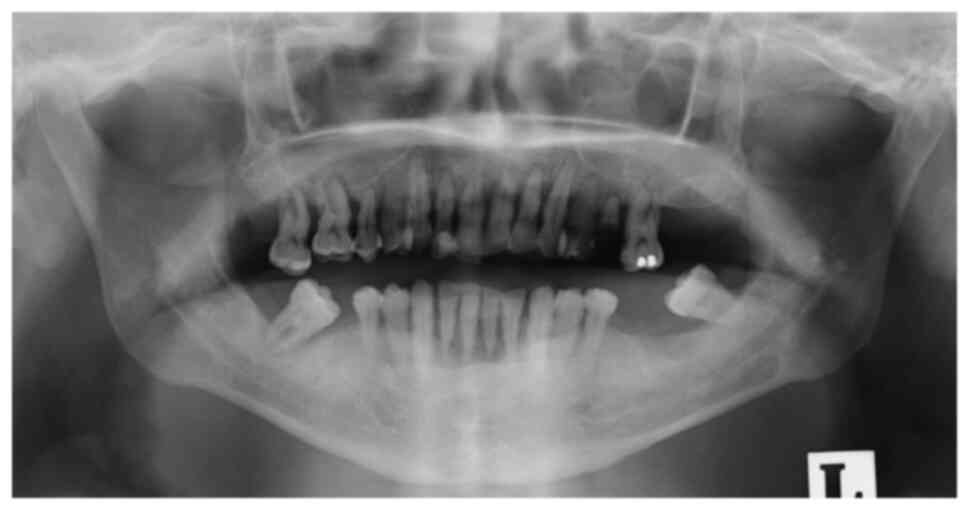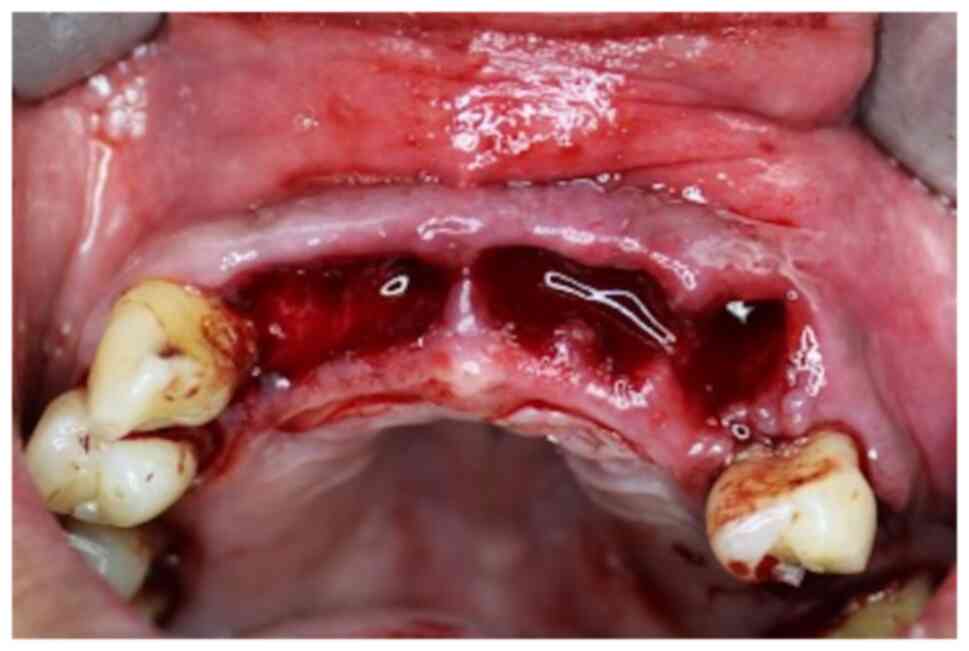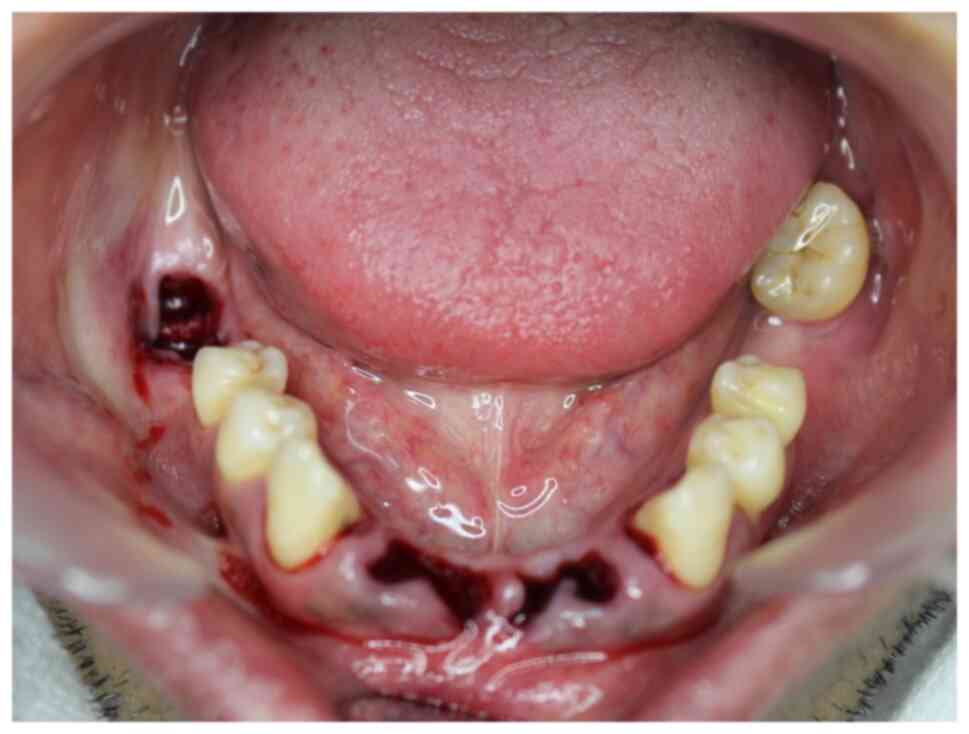Congenital factor XI deficiency with multiple tooth extractions (Case report)
- Authors:
- Published online on: September 15, 2023 https://doi.org/10.3892/etm.2023.12208
- Article Number: 509
Abstract
Introduction
First reported by Rosenthal et al (1) in 1953, congenital factor XI deficiency (CFXI) is a disease that causes deficiency in the endogenous coagulation factor XI. It is also known as hemophilia C or Rosenthal syndrome. The incidence of CFXI is one of every one million individuals, making it a rare blood disease (2). Although CFXI is inherited as an autosomal recessive trait, some FXI mutations exhibit an autosomal-dominant inheritance pattern. The FXI gene, responsible for CFXI, is located on chromosome 4. Unlike hemophilia A or B, which follows an X-linked inheritance, CFXI follows an autosomal inheritance pattern. It differs from hemophilia A or B in that affected patients show a variable bleeding tendency despite severe deficiency (<20%). While spontaneous bleeding is rare, individuals with CFXI may experience significant bleeding after trauma or surgery (3).
The oral region is hyperfibrinolytic and more prone to bleeding than other regions (4). There are few reports (5-8) of surgical procedures being performed in the oral cavity of CFXI patients. In the present report, we were able to perioperatively perform multiple tooth extractions without inducing abnormal bleeding by administering fresh frozen plasma (FFP) prior to surgery and maintaining sufficient local hemostasis in patients with CFXI.
Case presentation
The patient was a 43-year-old man with a height of 170 cm, weight of 90 kg and good nutrition. He had a history of meniscal injury due to sports trauma. Prolonged activated partial thromboplastin time (APTT) was observed during preoperative assessment for meniscal injury and further evaluation by a hematologist confirmed the diagnosis of CFXI. However, the patient did not receive any treatment or follow-up for CFXI. A family history investigation after establishing the diagnosis revealed that the patient's father had CFXI. The patient's son was not tested; hence, it was uncertain whether he also had CFXI. The patient had a history of tooth extraction before the diagnosis of CFXI was established, but there were no abnormal bleeding episodes. The patient visited a referring physician with a chief concern of chewing difficulty due to tooth mobility. Owing to severe periodontal disease, teeth 721┴1235 and 721┬12 have been diagnosed as requiring extraction. Considering the patient's history of CFXI and the requirement to perform multiple extractions, a high risk of bleeding was anticipated and the patient was referred to Kyoto University Affiliated Hospital (Kyoto, Japan). During the initial visit, subcutaneous bleeding or purpura were not observed in the limbs or joints. Extraoral examination revealed symmetric facial appearance, with no signs of subcutaneous bleeding or purpura. Intraoral examination revealed mobility of teeth 721┴1235 and 721┬12, as well as the presence of dental calculus. The gingiva showed mild redness and swelling but no purpura or bleeding were observed (Fig. 1). Panoramic radiography findings showed horizontal bone resorption in the mandible (Fig. 2). Blood test results at the initial visit showed a white blood cell count of 5,400/µl, a red blood cell count of 530x104/µl and a normal prothrombin time (PT) of 11.4 sec. The APTT was prolonged to 97.8 sec and the activity of FXI was <3%, indicating an abnormal value. Factors II, V, VII, VIII, IX, X and XI levels were within the normal range.
Prior to performing multiple tooth extractions, we conferred with the hematologist and decided to perform an FFP transfusion to replenish FXI. The maxillary teeth were extracted on the 2nd day of admission and the mandibular teeth on the 4th day. FFP was administered with 2 units each on the day before the extraction and the day prior to that.
The extraction in the maxilla was first performed at 7┘. Infiltration anesthesia was applied with 2% xylocaine (containing 1/80,000 epinephrine) and 7┘ extracted. The bleeding was similar to that of a normal tooth extraction and the blood clot was stable. Therefore, infiltration anesthesia to 21┴1235 was applied in the same manner and the teeth extracted in order. Here too, the bleeding was normal and blood clot retention was good. A gelatin sponge (Spongel®) was placed in the extraction socket, pressure hemostasis and suturing performed and a wound protection splint we had prepared in advance attached (Fig. 3). Although we achieved sufficient hemostasis, 1,000 mg of tranexamic acid (TXA) was required for additional hemostasis. No postoperative bleeding was observed and found that the blood clots were retained sufficiently on day 3 of admission.
The extraction of tooth 7┐ was performed on the 4th day of admission. The method of anesthesia, post-surgical bleeding and clot retention was similar to the maxillary teeth. Considering that hemostasis was possible, infiltration anesthesia was applied to 21┬12 in the same manner and the teeth extracted. Since the blood clot was well-retained, a gelatin sponge was not inserted (Fig. 4). Instead, hemostasis was achieved through coagulation using a carbon dioxide laser, sutures placed and a wound protection splint attached. TXA was not administered and postoperative bleeding was not observed. On day 5 of admission, a carbon dioxide laser was applied for tissue activation. On the following day (day 6), the patient was discharged because of good blood clot retention was good and no postoperative bleeding.
To manage the wound protection splint hygienically, the patient was instructed to gargle after meals and clean the surface of the wound protection splint. After discharge, the wound protection splint was to be worn for the entire day. The thread and the splint were removed 7 days after each tooth extraction. There was no abnormal bleeding or delayed healing postoperatively.
Discussion
CFXI is a rare disease that causes deficiency in endogenous blood coagulation factor XI (a plasma thromboplastin precursor) (9). CFXI rarely causes spontaneous bleeding in patients with other coagulation factor deficiencies, such as hemophilia A and B, but may cause major bleeding after trauma or surgery (3). This is because platelet factor XI -like activity is involved in the contact phase of endogenous coagulation, which means that even if the activity of plasma factor XI in CFXI patients is low, it becomes compensated for by platelet factor-like activity and blood coagulates (10).
Bleeding is generally considered to occur easily in the oral cavity, pharynx and genitourinary system, i.e., areas with high fibrinolytic activity (4) that fall within the range of oral surgical procedures. FFP replacement therapy is generally used as a preventive and therapeutic method to control bleeding due to factor deficiency and has also been administered to CFXI patients in receiving oral and maxillofacial surgery (5-8).
However, in clinical practice, it takes 2-5 days to determine the test results of factor XI activity. This means that it can be useful for preoperative evaluation but is not practical as an index of perioperative bleeding. By monitoring the healing process of patients who underwent FFP supplementation and local hemostasis, it may be possible to reduce the amount of blood transfused by supplementing with additional FFP when hemostasis is difficult.
Hemostasis after tooth extraction includes filling the extraction socket with cellulose oxide or collagen sponge, suturing the wound edge and asking the patients to bite down on the gauze for 20 to 30 min to stop bleeding by compression (11). In addition, the Food and Drug Administration (FDA) describes the ‘coagulation of extraction sites’ in the guidelines for using a dental laser during treatment and irradiation with a carbon dioxide laser for coagulation after tooth extraction as a recommended practice (12).
In the present case, considering that the effect of coagulation was sustained due to the long half-life of FFP, 2 units of FFP were administered before surgery and additional FFP added when the hemostasis was insufficient even after applying local hemostasis. For local hemostasis, the maxilla was filled with a collagen sponge and sutured and the mandible was irradiated with a carbon dioxide laser and sutured to ensure reduced perioperative bleeding. TXA, an antifibrinolytic drug, is known to be very effective in reducing bleeding (13), which is why it was administered during the first maxillary tooth extraction when we did not know the degree of bleeding. TXA was not administered when the mandibular tooth was extracted because good hemostasis had been achieved.
Previously, the timing of FFP use has varied in patients with CFXI undergoing maxillofacial surgery (5-8) (Table I). Gray et al (5) reported that FFP was administered preoperatively, intraoperatively and postoperatively to treat multiple facial fractures without bleeding. Ilankovan et al (6) reported the administration of FFP pre-, intra- and post-operatively in pharyngeal flap surgery, resulting in no postoperative bleeding. In cases of Le Fort III osteotomy, where FFP was administered pre- and intra-operatively but not post-operatively, they reported the occurrence of a hematoma in the rib harvested for bone grafting. Todd and Galbraith (7) reported that while performing extraction and Le Fort I osteotomy and sagittal split ramus osteotomy, FFP was administered pre- and post-operatively with no bleeding. Data are scarce regarding oral surgical procedures in patients with CFXI and future studies are warranted to clarify the dosage and appropriate timing of administering FFP. Poker et al (8) reported that a patient observed significant hemorrhage after one week of continuous bleeding following extraction of a mobile tooth at another hospital. A close examination following a hemostatic procedure revealed that the patient had CFXI. Furthermore, because hemostasis was difficult to achieve, the extraction socket was filled with thrombin-soaked cellulose oxide, closed with two intermittent polyvicryl sutures and pressure was applied with a gauze pack to achieve hemostasis. In the absence of special hemostatic measures during surgery in the maxillofacial region in patients with CFXI, there may be persistent or profuse bleeding after tooth extraction. Bleeding tendency of patients with CFXI is generally considered mild, even in severe deficiency and the bleeding phenotype does not correlate with FXI activity level and even mild deficiency may result in bleeding episodes (3).
Information on patients with CFXI undergoing oral maxillofacial surgery is currently limited. Although the use of FFP, local hemostatic agents and monotherapy antifibrinolytic therapy with TXA or ε-aminocaproic acid have been used for bleeding management, there is no definitive evidence regarding their effectiveness in reducing bleeding risk (3,5-8). Furthermore, the optimal combination of these multiple hemostatic agents has not been clearly established. Given the potential variations due to surgical invasiveness, systematic reviews of case series should be conducted to evaluate the efficacy of hemostatic methods. When unexpected or unexplained bleeding occurs after surgery or trauma, it is even more important to consider CFXI as a possible cause. If preoperative test results show a prolonged APTT, it may be necessary to consider coagulopathy to exclude or identify CFXI deficiency.
In the present case, we hypothesized that by supplementing FXI with FFP before surgery and by carefully administering appropriate hemostatic procedures, we could safely perform tooth extractions without supplementing FFP during and after surgery and without persistent postoperative bleeding. This is considered an important report for future data accumulation and is, therefore, reported here.
CFXI may not be diagnosed during oral and maxillofacial surgery but can become apparent after the surgery. CFXI should be considered if there is an increase in ATPP during the preoperative examination or abnormal bleeding during or after surgery. Further, in patients who have already been diagnosed with CFXI, preoperative FFP administration and appropriate local hemostatic methods may reduce the risk of perioperative bleeding and ensure patient safety. Since appropriate local hemostasis appears to reduce the need for FFP, we have reported our results with a review of the literature.
Acknowledgements
The authors would like to thank Dr Satomi Ueda (Department of Hematology, Hirakata Kosai Hospital, Hirakata, Japan) who contributed to patient treatment and care.
Funding
Funding: No funding was received.
Availability of data and materials
All data generated or analyzed during this study are included in this published article.
Authors' contributions
TK acquired patient data, performed the literature review and edited the manuscript. TK conceived and designed the present study. MY, TW, SY, SF and KN acquired the data, provided clinical advice and revised the manuscript. TK wrote the manuscript. TK and MY confirm the authenticity of all the raw data. All authors read and approved the final manuscript.
Ethics approval and consent to participate
Not applicable.
Patient consent for publication
Written informed consent was obtained from the patient for the publication of this case report and the accompanying images.
Competing interests
The authors declare that they have no competing interests.
References
|
Rosenthal RL, Dreski OH and Rosenthal N: New hemophilia-like disease caused by deficiency of a third plasma thromboplastin factor. Pros Soc Exp Biol Med. 82:171–174. 1953.PubMed/NCBI View Article : Google Scholar | |
|
Mumford AD, Ackroyd S, Alikhan R, Bowles L, Chowdary P, Grainger J, Mainwaring J, Mathias M and O'Connell N: BCSH Committee. Guideline for the diagnosis and management of the rare coagulation disorders: A United Kingdom Haemophilia Centre Doctors' Organization guideline on behalf of the British Committee for standards in Haematology. Br J Haematol. 167:304–326. 2014.PubMed/NCBI View Article : Google Scholar | |
|
Lewandowska MD and Connors JM: Factor XI deficiency. Hematol Oncol Clin North Am. 35:1157–1169. 2021.PubMed/NCBI View Article : Google Scholar | |
|
Wheeler AP and Gailani D: Why factor XI deficiency is a clinical concern. Expert Rev Hematol. 9:629–637. 2016.PubMed/NCBI View Article : Google Scholar | |
|
Gray PB, Leen MM and Loftus MJ: Late retrobulbar hemorrhage and blindness following malar fracture complicated by factor XI deficiency. J Oral Maxillofac Surg. 51:699–702. 1993.PubMed/NCBI View Article : Google Scholar | |
|
Ilankovan V, Blesing NE, Moos KF and Davidson JF: Correction of facial deformities in patients with mild bleeding disorders: A report of three cases. Br J Oral Maxillofac Surg. 28:398–400. 1990.PubMed/NCBI View Article : Google Scholar | |
|
Todd D and Galbraith D: Management of an orthognathic surgery patient with factor XI deficiency: Review and case report. J Oral Maxillofac Surg. 51:417–420. 1993.PubMed/NCBI View Article : Google Scholar | |
|
Poker ID, Reade PC and Cook RM: Factor XI deficiency disclosed following haemorrhage related to a dental extraction. Brief review and case report. Aust Dent J. 35:258–260. 1990.PubMed/NCBI View Article : Google Scholar | |
|
Emsley J, McEwan P and Gailani D: Structure and function of factor XI. Blood. 115:2569–2577. 2010.PubMed/NCBI View Article : Google Scholar | |
|
Tuszynski GP, Bevacqua SJ, Schmaier AH, Colman RW and Walsh PN: Factor XI antigen and activity in human platelets. Blood. 59:1148–1156. 1982.PubMed/NCBI | |
|
Perry DJ, Noakes TJC and Helliwell PS: British Dental Society. Guidelines for the management of patients on oral anticoagulants requiring dental surgery. Br Dent J. 203:389–393. 2007.PubMed/NCBI View Article : Google Scholar | |
|
Sulewski JG: Clearing the FDA hurdle, from initial device application through regulatory approval to the clinical operatory: An update on dental laser marketing clearances. J Laser Dent. 17:81–86. 2009. | |
|
Berliner S, Horowitz I, Martinowitz U, Brenner B and Seligsohn U: Dental surgery in patients with severe factor XI deficiency without plasma replacement. Blood Coagul Fibrinolysis. 3:465–468. 1992.PubMed/NCBI |













